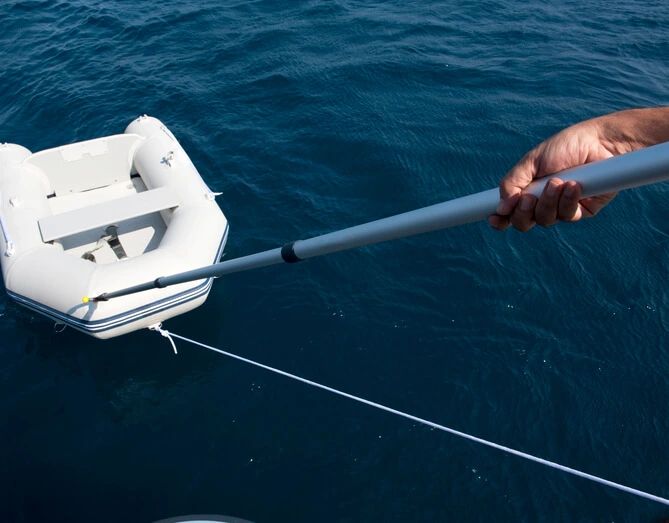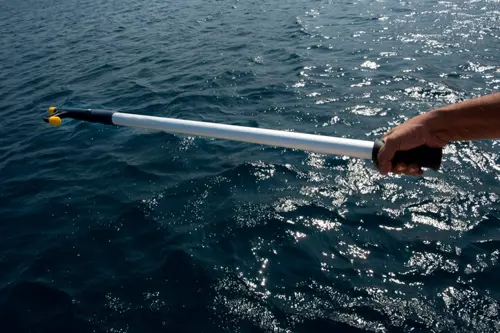What is a boat hook? Types, maintenance & using one safely
03 October 2025

A boat hook is a simple yet multifunctional tool that every boat should have. It’s something that can help with a whole range of tasks. In this guide, we share what a boat hook is, what it can be used for, different types of boat hooks, and tips for using yours safely.
Contents
- What is a boat hook?
- Parts of a boat hook
- What is a boat hook used for?
- How to use a boat hook
- Different types of boat hooks
- Tips for choosing the right boat hook
- Boat hook maintenance and safety tips
What is a boat hook?
A boat hook is a common tool used in boating and sailing and has many uses. It’s essentially a long pole with a hook and blunt tip on the end, which is very handy when it comes to completing different tasks on a boat.
It provides extended reach and extra control, especially when docking, mooring, or handling lines, and is an essential tool for anyone who spends time on the water. If you're new to sailing, you can check out our guide on learning how to sail.
Parts of a boat hook
Boat hooks are very simple and don’t have many parts. The four essential parts of a boat hook are its:
- Pole – gives the boat hook length and can be extendable
- Hook – typically made from plastic or metal and designed to pull and grab
- Tip – often rounded or rubberised and used for pushing and guiding
- Grip – ensures the boat hook can be held securely and is usually made from rubber or foam
What is a boat hook used for?
A boat hook can be used to perform multiple tasks on a boat. Some of its most common uses include:
- Pushing off from docks or other boats
- Pulling the boat towards a dock or mooring point
- Grabbing lines or ropes
- Retrieving objects that have fallen into the water
- Gently fending off other boats or obstacles
- Assisting with various docking manoeuvres
How to use a boat hook
How you use a boat hook depends on what you’re trying to achieve.
- Docking – if you’re docking your boat, you can use a boat hook to grab a mooring ring, rail, or cleat and gently pull the vessel in
- Pushing off – you can use the blunt tip of a boat hook to carefully push off a dock or another vessel and avoid collisions
- Grabbing a line or mooring buoy – the hook end of a boat hook can be used to grab a line or mooring buoy that’s out of reach
- Saving items from the water – if an item has fallen into the water, use the hook end to retrieve the item and lift it back on board
- Fending off – use the blunt end of a boat hook to gently push off walls, boats, or other obstacles to ensure you don’t collide with them. You should never use your hands or feet for fending off as this can be dangerous
Different types of boat hooks

Despite being simple in design, there are a few different types of boat hooks to choose from. A telescoping boat hook seamlessly extends, which allows for a longer reach and can be easily collapsed and stored away when not in use. A fixed-length boat hook is simpler and more durable but less compact than a telescoping version.
You can also buy a multi-function boat hook, which may feature threaded ends for attaching other tools, like deck brushes. When you don’t have a lot of space on your vessel, having a multi-function tool can be particularly useful.
Tips for choosing the right boat hook
Choosing the right boat hook might sound simple, but there are a few features to look out for depending on how you’ll be using it.
Length
While a standard boat hook might be long enough for your needs, those with a larger vessel might prefer a telescoping boat hook, which offers extended reach. A telescoping hook can also be more convenient if you have limited storage space on board, as it can be compacted when not in use.
Material
Most boat hooks are made from aluminium, fibreglass, or wood. Aluminium and fibreglass are typically seen as the best choices as they’re strong and durable. Wooden boat hooks are more traditional and have a better aesthetic, but are usually quite heavy and more difficult to maintain. Read our guide to painting a fibreglass boat if your vessel is made of this material.
Weight and grip
For ease of use, a lightweight boat hook is best as it reduces fatigue and is easier to control, especially when using just one hand. You should also opt for a boat hook with a non-slip handle so you can confidently grip the tool, even in wet conditions. Our tips for boating safely in a storm may also come in handy.
Boat hook maintenance and safety tips
As with all items of boat equipment, it’s important to maintain your boat hook to ensure it continues to work correctly and is always available when you need it. Only small maintenance tasks are required, but performing these can make a difference to the longevity of your boat hook.
- Rinse your boat hook with fresh water after use, especially if it’s been in contact with saltwater, to lower the risk of corrosion and degradation
- Occasionally, clean your boat hook with mild soap and water to remove any dirt or mildew that can build up and cause issues over time
- If you have a telescopic boat hook, ensure you use the mechanism frequently to prevent it from seizing up
- Check your boat hook for damage, as cracks or dents could make it less effective
- Store your boat hook in a dry location, where possible, to avoid wear and tear caused by unfavourable weather conditions
It’s important to use a boat hook safely and with care to avoid causing damage or sustaining an injury. When using a boat hook, remember to:
- Maintain balance and don’t overreach to ensure you don’t fall into the water
- Use both hands, if necessary, especially when pushing or pulling
- Never use it to stop a moving boat. It should only be used for gentle adjustments, not braking
- Stow it safely when not in use to avoid tripping over it or losing it in the water
Specialist boat insurance through Craftinsure
Now you know all about boat hooks and how to use them, you might like to think about purchasing specialist boat insurance for your vessel.
Specialist boat insurance through Craftinsure provides up to £5m third-party cover and can protect your boat against loss or damage from fire or theft. Get an online quote in minutes today.
Please note the information provided on this page should not be taken as advice and has been written as a matter of opinion. For more on insurance cover and policy wording, see our homepage.


